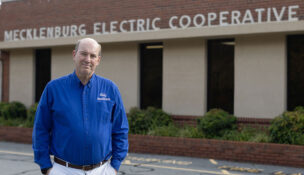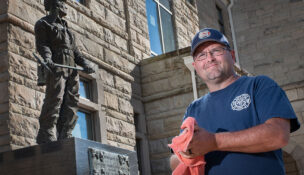LEEDing the way
Mandates and marketability push Virginia to the top among states in green development
Virginia Business //March 31, 2013//
LEEDing the way
Mandates and marketability push Virginia to the top among states in green development
Virginia Business //March 31, 2013//
If you’re wondering why Virginia placed first in the U.S. in a recent ranking of green development, the campus of Virginia Commonwealth University is a good place to start.
Long a laggard in the field of sustainable building, Virginia’s new star status as the top state was based on the number of buildings that qualified for LEED certification in 2012. LEED, which stands for Leadership in Energy and Environmental Design, is a voluntary program of the U.S. Green Building Council that gives a third-party rating (silver, gold or platinum) to the environmentally friendly elements of a building.
Since 2009 VCU has earned LEED status for eight new buildings and the renovation of a ninth, says Jacek Ghosh, VCU’s director of sustainability. Currently, about an eighth of the school’s total building space is LEED design, and by 2015 that will increase to a sixth of total space. “All of this means better performance, less carbon output and less energy [used], and less money spent,” says Ghosh.
Those buildings helped push Virginia to the top of the USGBC annual ranking, released in January. It showed Virginia had 170 projects with certified LEED status and a total of 29.7 million square feet. That’s 3.71 square feet of certified space per resident. Only the District of Columbia had a better showing with 36.97 square feet of LEED certified space per resident.
The voluntary LEED status isn’t really voluntary, though, for a lot of development in Virginia. Not only does the state require LEED certification in many of its buildings — including colleges and universities — many federal agencies do, too, for space they build or lease. So Virginia, with its big share of government and defense contractors, likely will stay at or near the top of that list.
LEED projects can cost more to construct, says Michael Divaris, president of Divaris Real Estate Inc., based in Virginia Beach. Typically it’s about a dollar per square foot more, he says, but tenants are willing. “In our market in Hampton Roads, it’s definitely something that is becoming an important element in new office construction as more tenants require certification,” he says.
Here are some examples of LEED projects around Virginia:
Metro Park VI: This 330,589-square-foot, Class A office tower in the 1.2 million-square-foot Metro Park in Alexandria is a prime spot for federal contractors. The building opened last summer with LEED Platinum status, the highest ranking. It was developed by The Evans Co. for New York-based Clarion Partners. A key part of its LEED ranking is energy savings — more than 35 percent less than a similar, conventionally designed building, Clarion says. Design elements include what the company calls “a lozenge-shaped tower with pinched east and west ends to reduce heat gains at those exposures” and a double-pane glass exterior. The building has 11 floors plus a concourse level. Each floor is divided into east and west zones served by separate air handling units to conserve energy. The HVAC system delivers about 30 percent more fresh air indoors than is required by building code, according to Clarion. The building was 60 percent preleased before it opened. One of the tenants is Booz Allen & Hamilton, which signed a 10-year, $40 million lease for 88,000 square feet.
VCU School of Medicine: Designed to LEED Silver status, the 12-story, 203,000-square-foot James W. and Frances G. McGlothlin Medical Education Center is set to open this spring. Its sustainable-design features include a storm water reclamation system that diverts rain on the roof to a tank for later use in toilets and urinals, or for use in the building’s cooling towers.
LEED Silver is the mandatory requirement, third behind the platinum and gold rating. VCU does go beyond the mandatory on some projects, such as the Walter L. Rice Education Building. It opened in 2009 with LEED platinum status. This $2.6 million building is located on the VCU satellite campus on the James River in Charles City County. Its green design and construction features include a vegetated roof system to reduce heat and storm water runoff, geothermal heating and cooling, and the use of recycled materials in its construction.
Ghosh says there are additional upfront costs with LEED projects, but they don’t get passed along to the state. “When we do LEED Gold or LEED Platinum, we have to find other dollars for that,” often through fundraising efforts. “The state says, ‘OK, if you want to have that building, go find the money for it.’” In all, the new VCU projects total 617,714 square feet with a total cost of $192 million and include academic buildings, a renovated gym and a new student center.
Virginia Beach Town Center: This mixed-use project in Hampton Roads continues to grow, and the growth includes LEED development. Divaris’ firm is handling leasing for a new, 14-story mixed-use building. Armada Hoffler broke ground on the project last month, and the tower is scheduled to be complete by July 2014.
The building itself will be constructed to LEED Silver status in the category “core & shell” that is used when the developer controls only parts of the building, such as the mechanical, electrical and plumbing systems. The tenants can do what they want in their space. One of the anchor tenants, architecture and engineering firm Clark Nexsen, plans to seek LEED status. Last fall it signed a lease for four floors totaling 80,000 square feet in the new building and will move its headquarters from Norfolk when the project is complete.
Rebekah Burke, director of sustainable design for Clark Nexsen, says the firm is planning to seek silver and maybe gold LEED certification for its space. “We would really like to get gold. A lot of times the difference is decisions you make during design and construction,” she says.
Clark Nexsen doesn’t have to seek LEED status but will do so anyway. “I think it’s the right thing to do,” Burke says. “Typically what I’ve seen in my experience is that a building that is certified LEED is a high-quality building. It’s going to be a high-performing building.” Potential tenants notice the difference, she adds.
In Virginia the mandates from the state and federal levels are making the private sector more aware, says Jerry Walker, chairman of the Virginia Sustainable Building Network and energy manager for Henrico County. The reality is that putting your employees and customers in a healthy, environmentally friendly building “is very popular,” he says.
“Yeah, it costs a little bit more, maybe 1 percent of the total cost of the project, but it’s catching on,” he says. “People are seeing it as a good thing to do.”
e
















